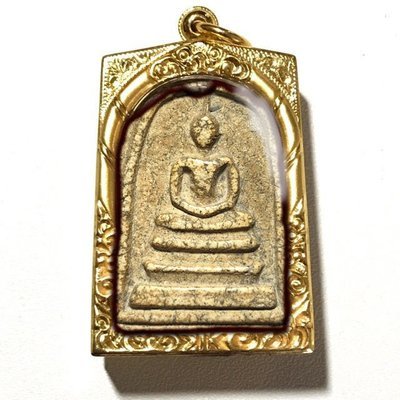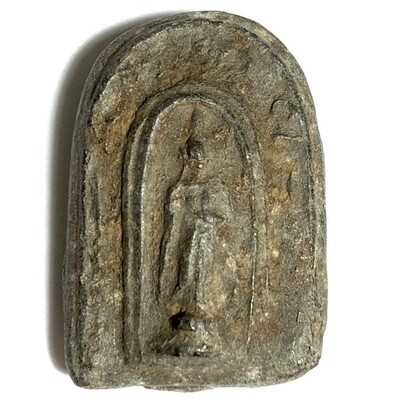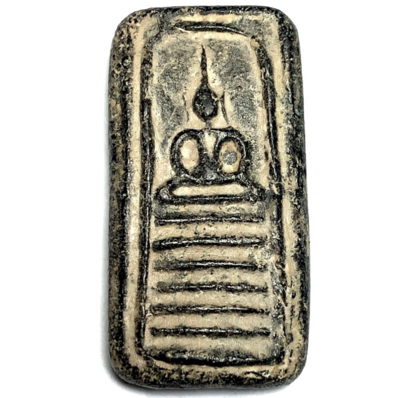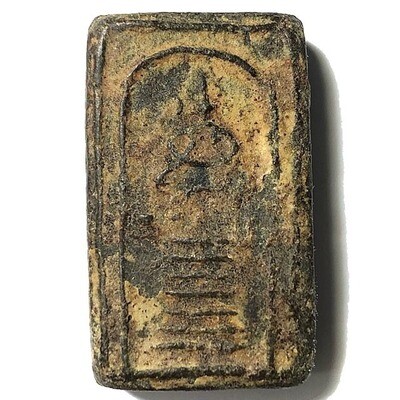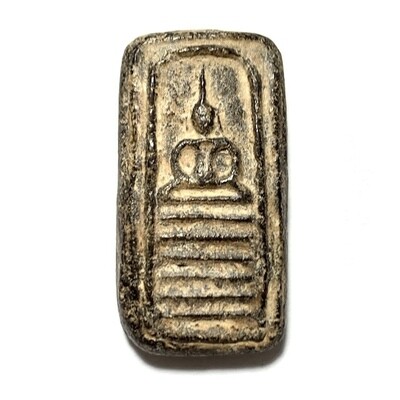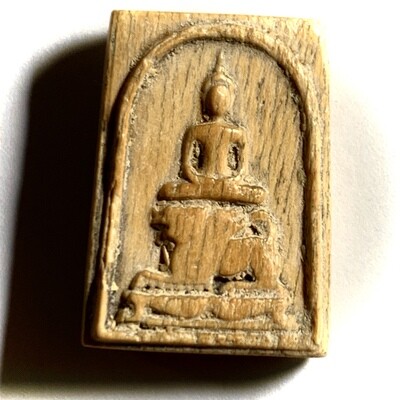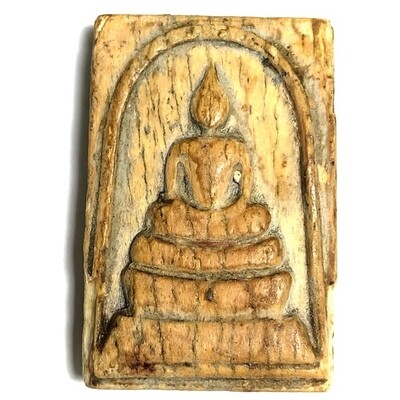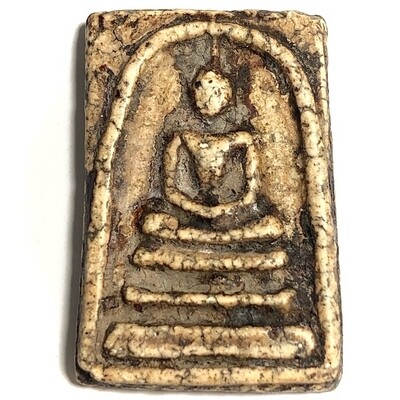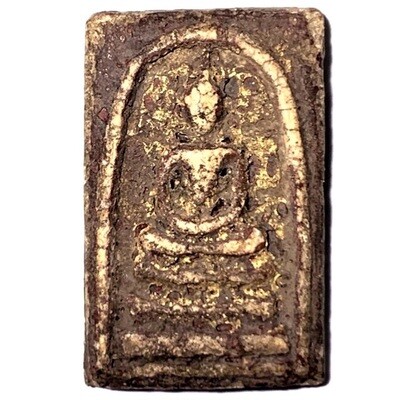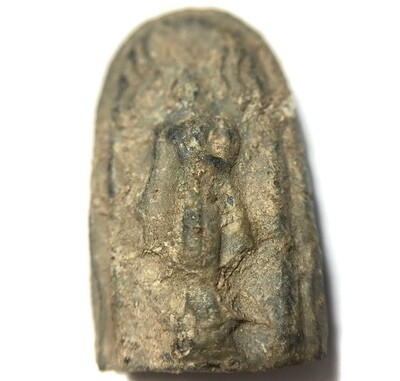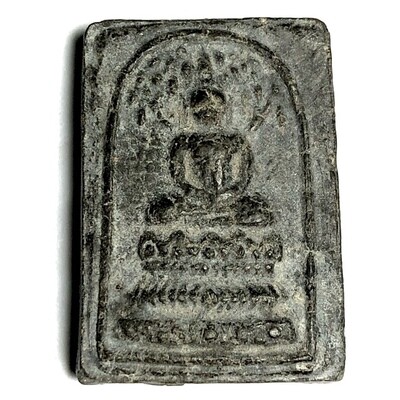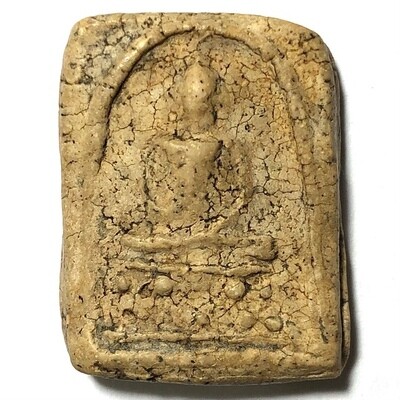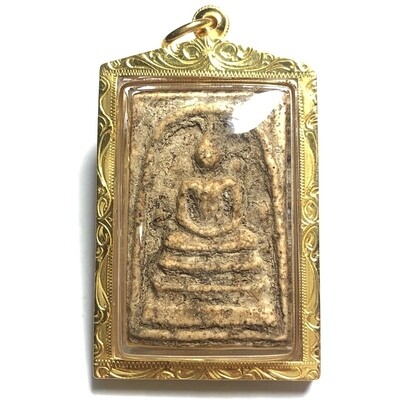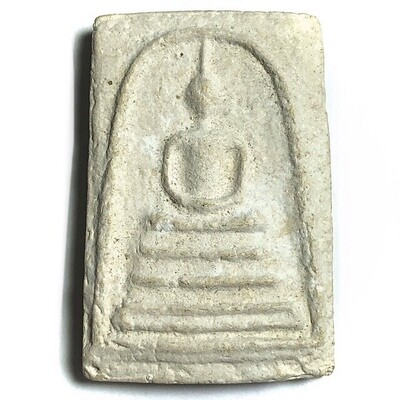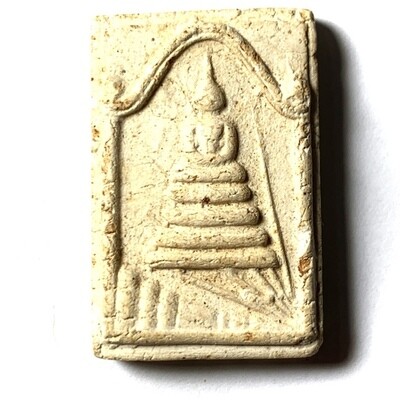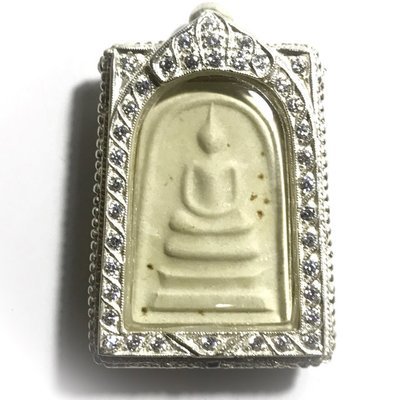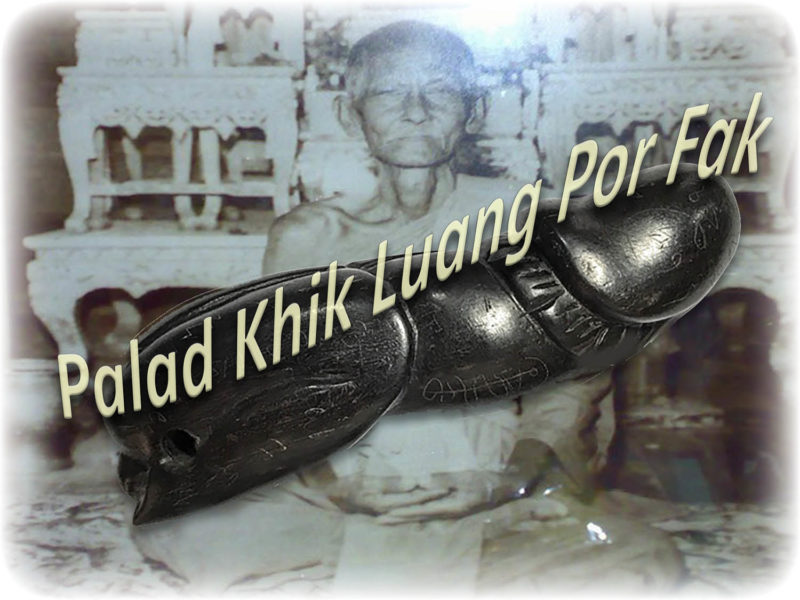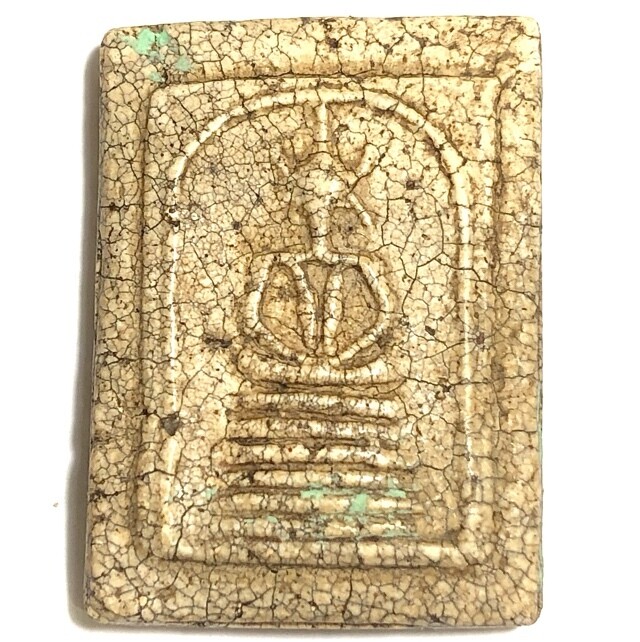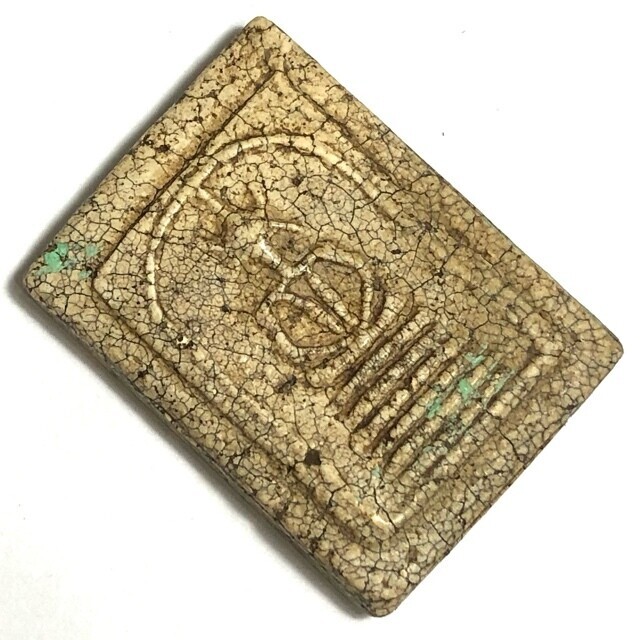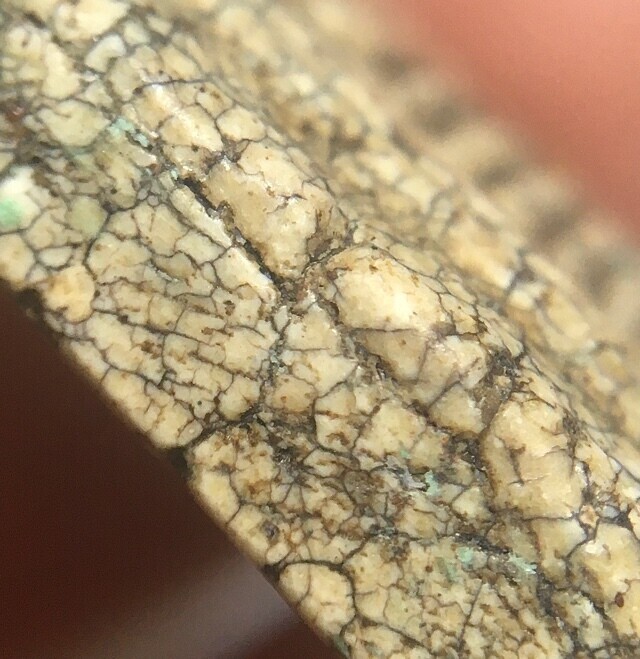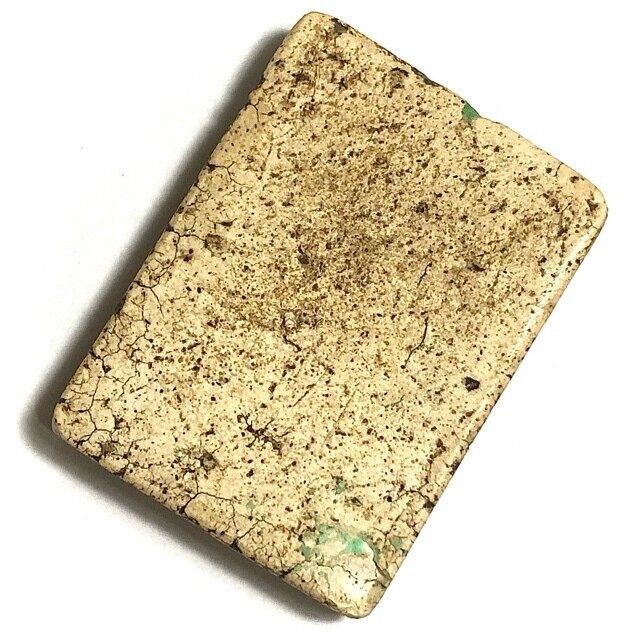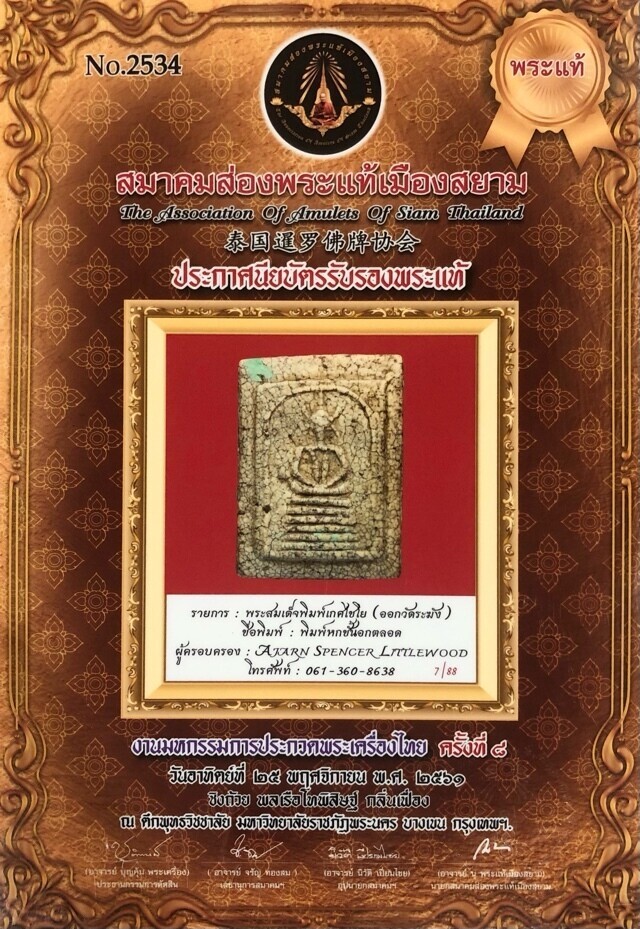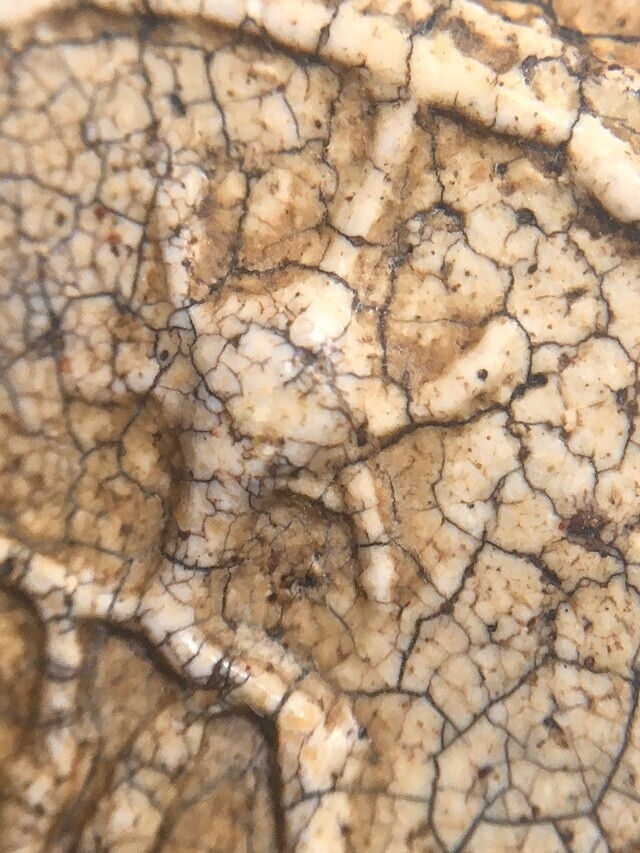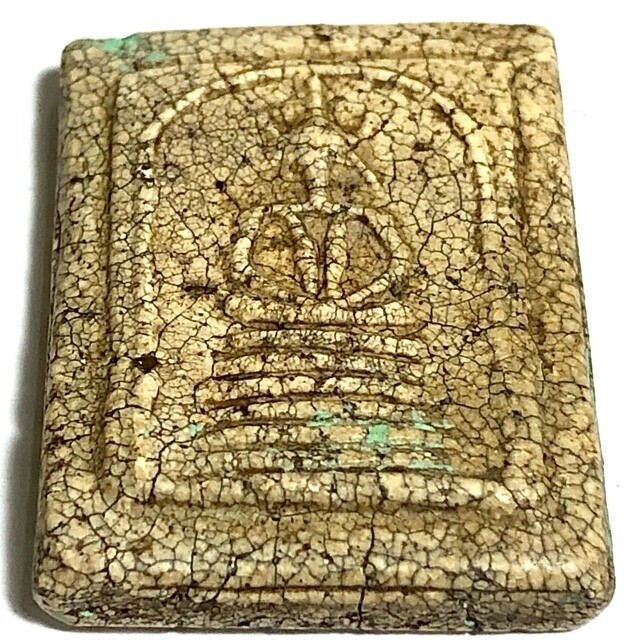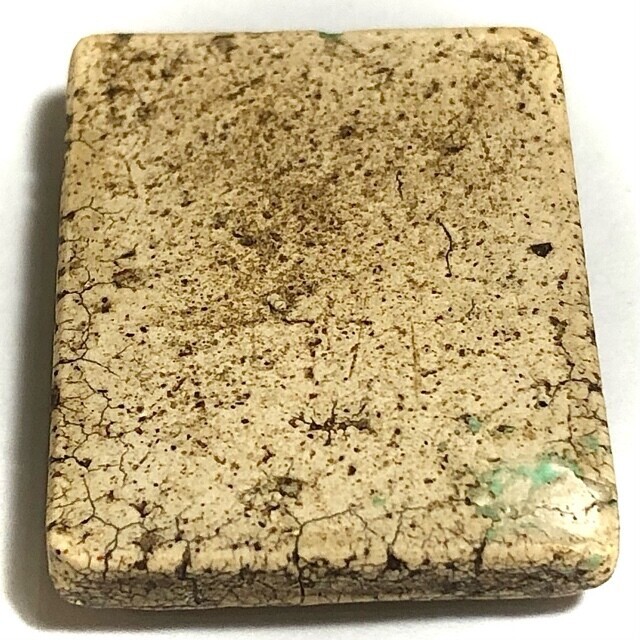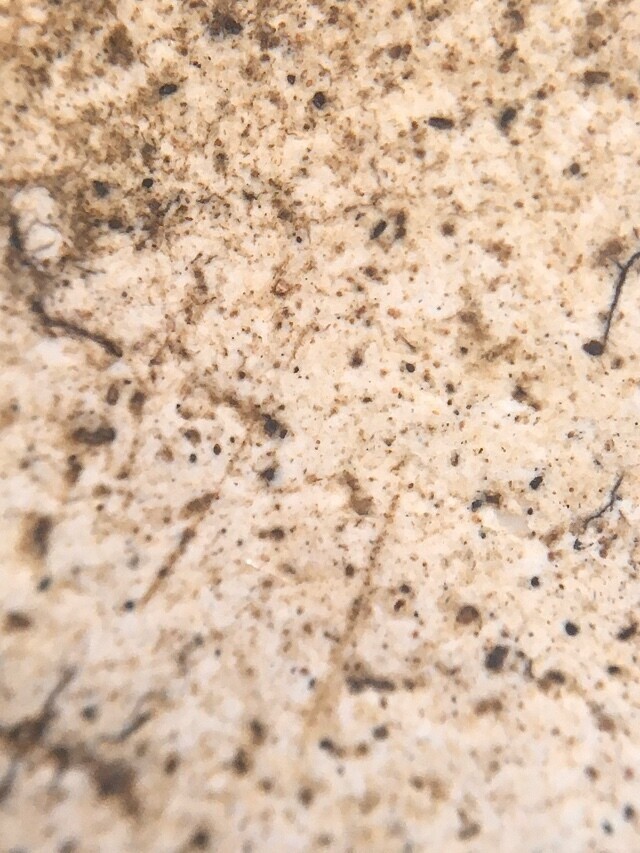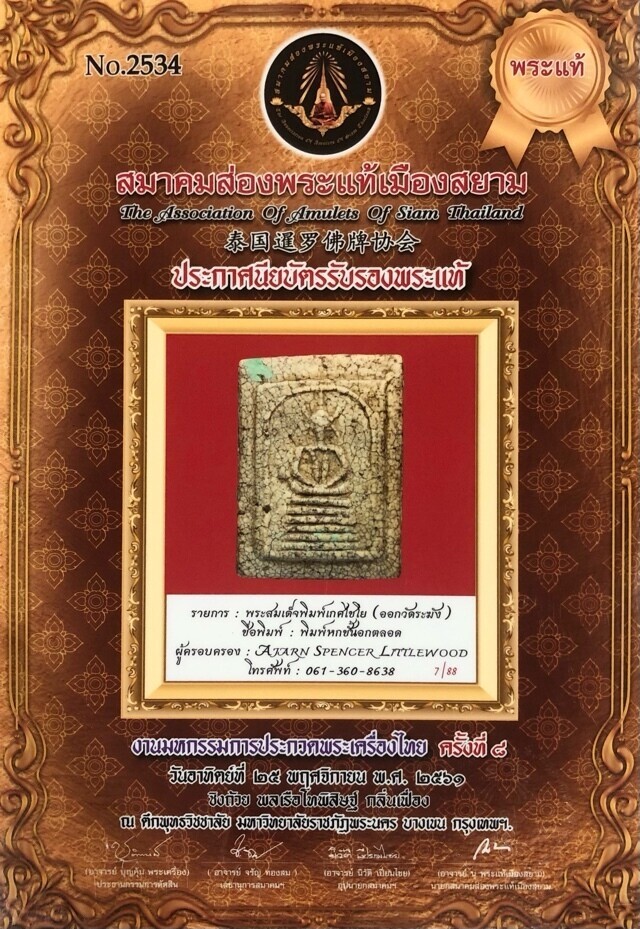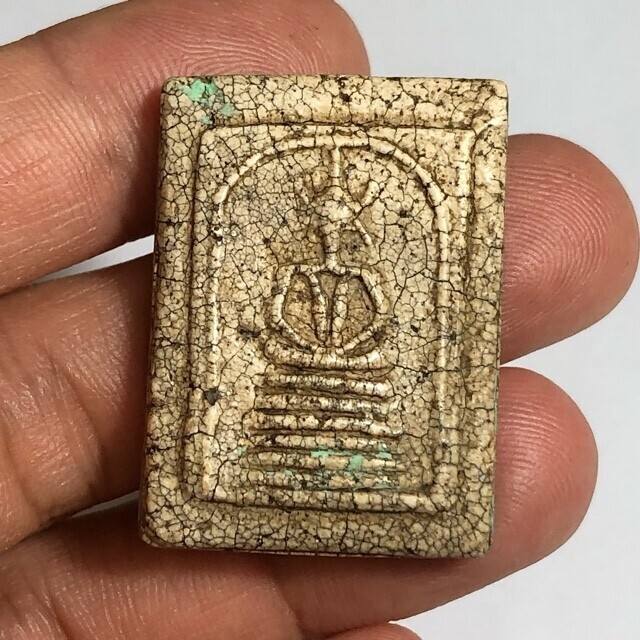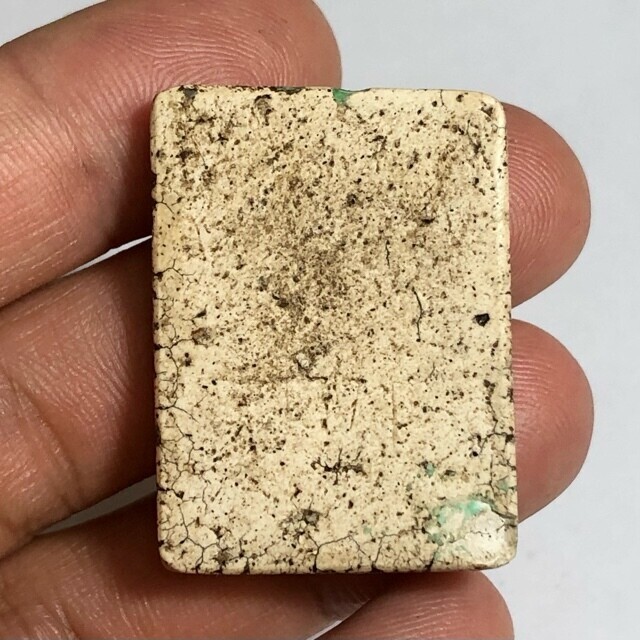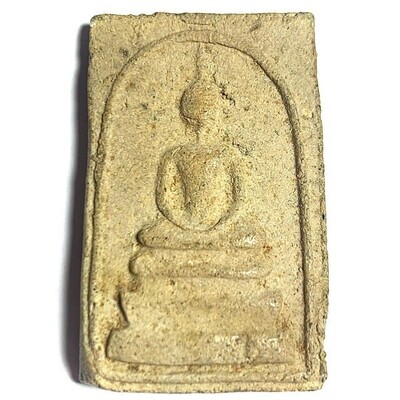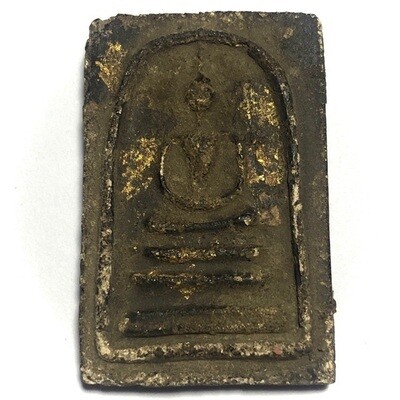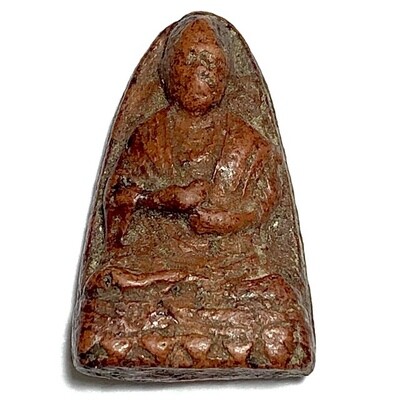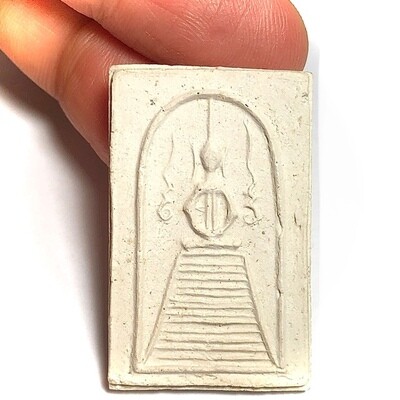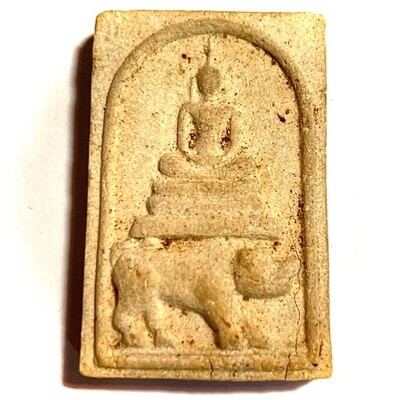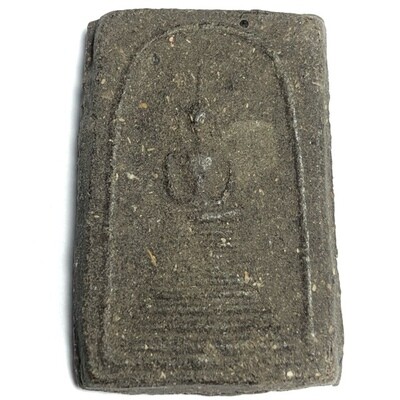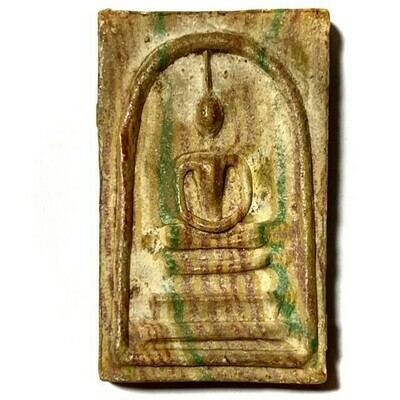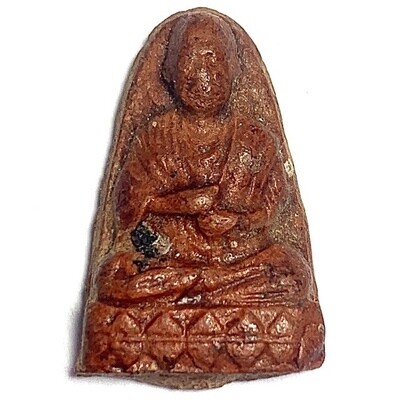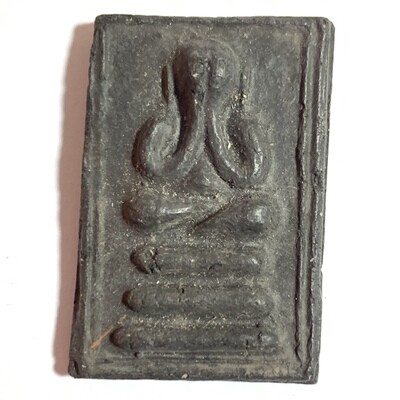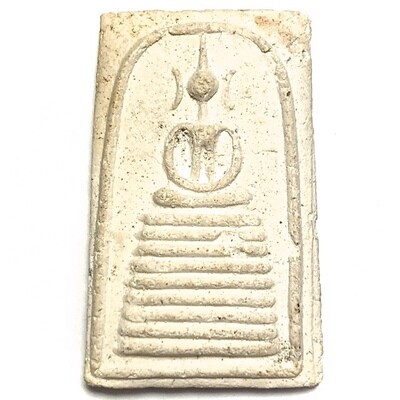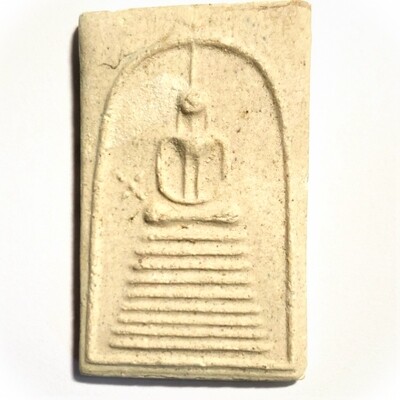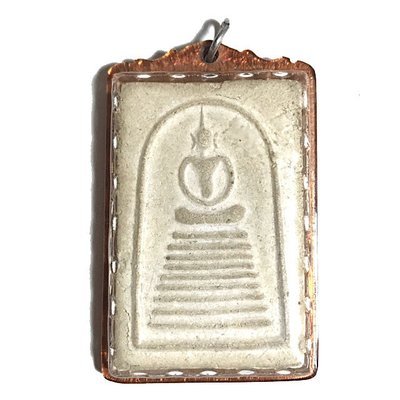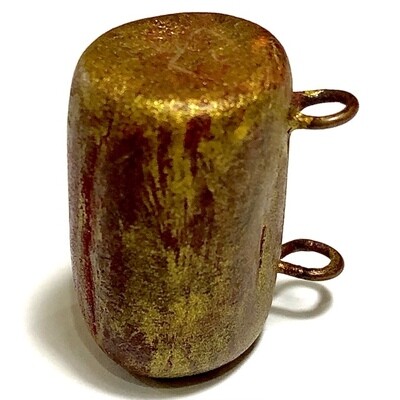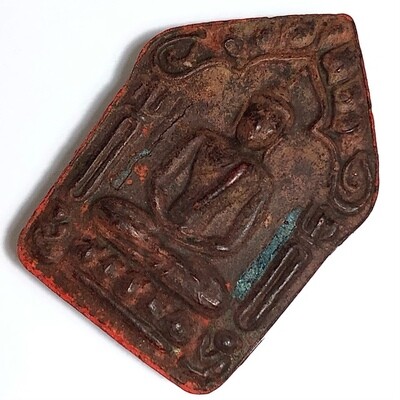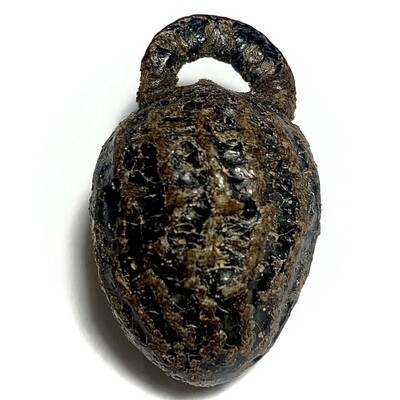One of the rarest and most highly revered and sought after Palad Khik of all Time, the Palad Khik Gae Nuea Mai Paya Ngiw Dam Dong Jarn Mer, of Luang Por Fak, of Wat Nikom Prachasan. Hand carved from sacred Deva inhabited black Ngiw treewood. The Palad Khik of Luang Por Fak is considered amongst the top five Palad Khik of all time, and carries Supreme Eminence in the Thai Collector Scene of the Krueang Rang Category, and for all Devotees of Palad Khik amulets.
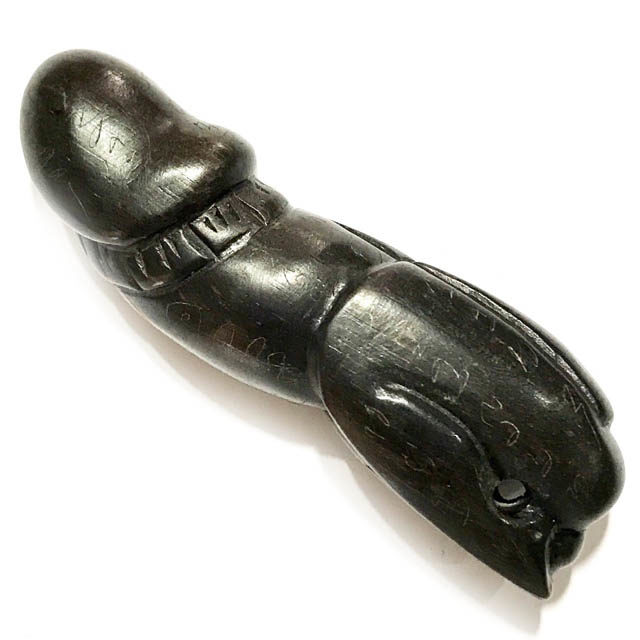
Palad Khik Mai Ngiw Dam Dong LP Fak with Hand Spell Inscriptions
Little is known of his Biography or Life before ordination, but it is known that he was the apprentice in Wicha to the great Luang Por Soke (also top 5 Palad Khik Master), and was the4 Kroo Ba Ajarn who taught the Wicha Palad Khik to the Great Luang Por Yid, of Wat Nong Jork. This Palad Khik from Luang Por Fak is in Pristine condition and exquisitely carved in the classic uniquitious curved shape which has come to be a trademark with the Palad Khik of Luang Por Fak.
A hole is drilled through the base of the Palad Khick for threading a cord through and attaching to a waistcord belt, or can alternatively be encased in waterproof casing with pendant hoop for wearing on a neckchain or belt as preferred.
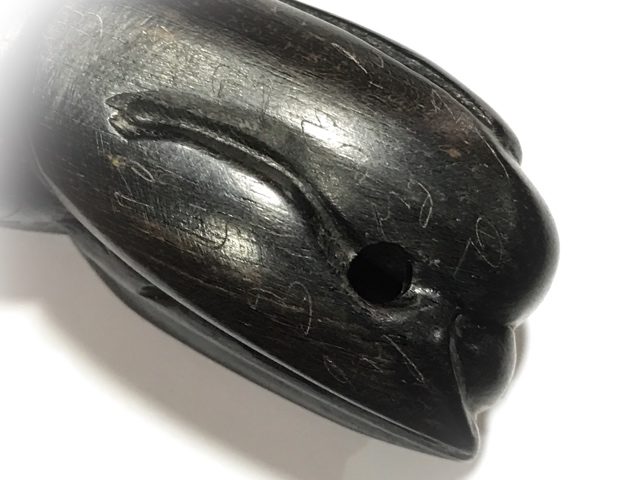
Hole drilled in base of Palad Khik Mai Ngiw Dam Dong LP Fak, for threading a cord for attachment to a belt or neckchain – Hand spell inscriptions can be seen on the surface of the sacred black Paya Ngiw Dam Dong Treewood.
The back of the Palad Khik has three holes where special Muan Sarn is inserted. The body of the the Palad Khik is formed in the clasic curved shape which has become known to be ubiquitous with the Palad Khik of this Master. This exhibit is extremely rare for the hand inscription of the Yant Dan Dta (Yant Dto) on the head of the Palad Khik, which is said to be found on only very rarely.
The Palad Khik of Luang Por Fak are highly renowned for Kong Grapan Chadtri (Invincibility), Klaew Klaad (Evasion of Deadly Accidents), Metta Maha Niyom n(Mercy Charm), Kaa Khaay (Selling Power), and Lai Phuudt Phii Pisaj (Chase Demons and Ghosts Away).
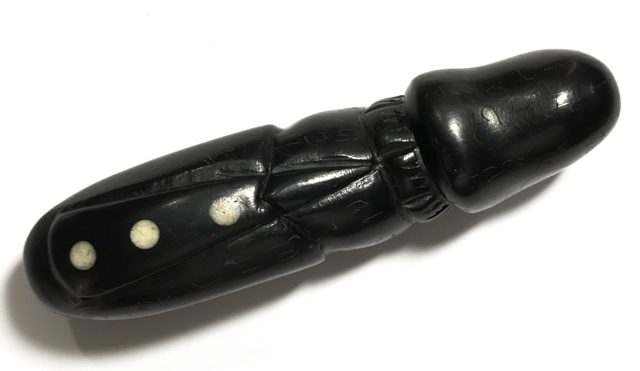
3 Muan Sarn Inserts in the Palad Khik Mai Ngiw Dam Dong LP Fak
The Palad Khik is empowered with the Kata; NA HI HA HU JA CHA DAN DTA
And the Kata Hua Jai Taw Waes Suwan “WAE SA PU SA”, and the Kata Hua Jai Ittijae for Metta Maha Sanaeh “I TA KA MA”, as well as the Kata Hua Jai Metta Karaniya Sutta “AE DTANG SA DTING”, topped off with the Hua Jai Maha Ud “UT TANG AD TO”.
11 Kinds of Blessings are included within the Magic of the Palad Khik’s Wicha; 1. Sleep peacefully, 2. Awaken with Happiness, 3. Protection against all Deadly Weaponry, 4. Immunity to Poisons, 5. Mercy Charm, 6. Good Business and Wealth Increase, 7. Convincing Speech, 8. Ward off Evil Spirits and Ghosts, 9. Improve Karma, 10. Protect Household and Property, 11. Increase Popularity & Chances of Promotion.
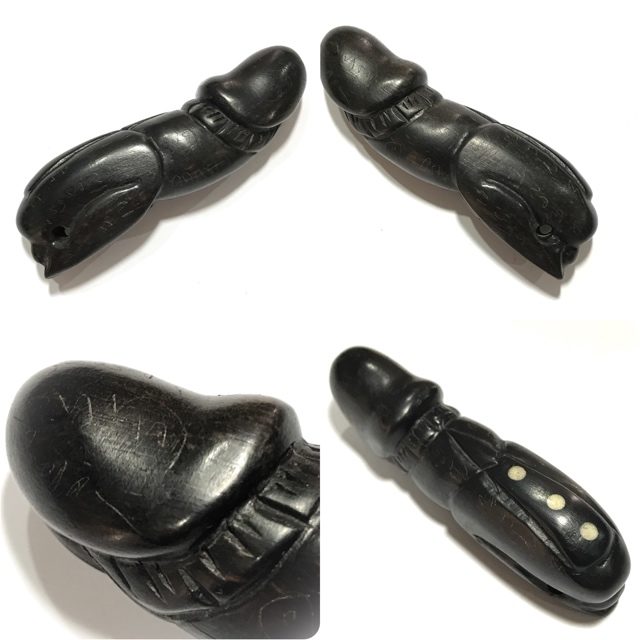
Palad Khik Mai Ngiw Dam Dong LP Fak
The Palad Khik is an Ancient Wicha, whose development can be traced right back to the Vedic Brahman Occult practices of Thousands of Years ago. Palad Khik amulets must be empowered by the repetition of incantations, which Thais call ‘Kata Bucha’, derived from the Devanagari ‘ghata poojah’. The incantations depend on the creator’s lineage in each school of traditional non-Buddhist animist magic.
Kata Bucha Palad Khik
Ganha Neha Na Ma Pa Ta
or
Ja Pa Ga Sa Na Mo Put Taa Ya Gan Ha Nae Ha Na Ma Pa Ta
or
Om Siwaling Sabbha Metta Sabbha Pokaa Sabbha Laapo Sabbha Tanaa, Sabbha Yasa, Sabbha Pranee Sabbha Mangalaani Bhavantume.
or
Om Laluay Mahaa Laluay Samsip Sorng Hee Hae Hom Lorm Dtorm Kuay Khor Hai Guu Ram Ruay Pro Hua Kuay An Nii Da Daa Di Dii Duu Dii Hee Maa Kuay Maa Burut Maa Dii Sadtrii Mii Maa Swaa Home
chant any one, or all of the Kata 3 times holding the Palad Khik before wearing
Pra Somdej Gaes Chaiyo Pim Hok Chan Ok Dtalord Niyom Ongk Kroo Preferred Model Somdej Pra Puttajarn Dto Prohmrangsri
Presenting an extremely rare, revered and most highly sought-after amulet of the Benjapakee Amulet family, and a Classic Master-Class 'Ongk Kroo' Pim Niyom ancient amulet of the great Somdej Pra Puttajarn (Dto) Prohmrangsri of Wat Rakang Kositaram; The Pra Somdej Wat Gaes Chaiyo, Pim Hok Chan Ok Dtalord, which comes with authenticity certificate from the association of amulets of Siam Thailand. This exhibit displays a beautiful surface texture with crackled effect, known as 'Dtaek Lai Nga', whgich is an effect arising from environmental conditions over the ages, and a naturalk occurrence in some exhibits, which are highly preferred for this beautiful effect, which renders even more depth and character to what is already one of the top 5 Benjapakee Thai amulets of all time.
The Pra Somdej Thaan 6 Chan amulet holds a special place among the various models of Pra Somdej Wat Gaes Chaiyo amulets. This particular amulet, along with the Pra Somdej Thaan 7 Chan and Pra Somdej Thaan 6 Chan Ok Dtan, are all the most highly confirmed as authentic by various experts in all amulet associations, is certificated authentic already, as well as undergoing three years of perusal and study by our proprietor Ajarn Spencer, whose decades of expertise in collection and perusal of Pra Somdej amulets of all three major, and multiple minor temples of Somdej Pra Puttajarn (Dto) Prohmrangsri.
This exhibit is particularly beautiful for the 'Dtaek Lai Nga' 'crackled ivory' pattern on the surface which has formed over the many years since its making. The amulet's smooth domino like surface texture from compactness, its aged dryness, uneven discoloration, and stains are highly indicative of the age and authenticity associated with Wat Gaes Chaiyo. In fact, the texture of this amulet can be classified as 'Nuea Graeng', for it is as hard as stone, despite its shiny appearance, and feels like marble in the hand when you run your finger over the smooth rear face.
Pra Somdej Wat Gaes Chaiyo is one of the four Royal temples officially recognized as the origin of Pra Somdej amulets, along with Wat Intr, Wat Hmai Bang Khun Prom, and Wat Rakang Kositaram. However, officially in Thailand we refer to them as 'Somdej Sam Wat' (Somdej of three temples) because Wat Intr (Wat Intrawiharn Bang Khun Prohm), and Wat Ban Khun Prohm Nai, are contained within the same temple boundary enclave, and have melded into one. These amulets are considered to be part of the Benja Pakee official set, which represents the most sacred and desirable amulets of Thailand, symbolizing each region of the country.
The Pra Somdej Thaan 6 Chan Ok Dtalord amulet is just one of the many models within the Pra Somdej Wat Gaes Chaiyo collection. Other models include the Pra Somdej Thaan 7 Chan, Pra Somdej Thaan 6 Chan Ok Dtan, and this Pra Somdej Thaan 6 Chan Ok Dtalord. These amulets are highly esteemed and sought after by both Thai and foreign amulet collectors. In terms of the Pra Somdej Wat Gaes Chaiyo amulets, it is crucial to be cautious of fake versions. Some amulets falsely claim to be from Wat Pra Gaew, featuring King Rama 5 on the rear face, when in fact, they are complete fakes. These fanciful fake amulets often have a strong chemical smell from gold paint and chemical lacquer. It is essential to be aware of such presentations and always seek authentic sources.
When examining the Pra Somdej amulets, it is important to note that the judgment of authenticity does not solely rely on the appearance of the amulet. While the appearance should align with the basic description, the age and content of the Muan Sarn (sacred powder) play a significant role in determining authenticity. The Pra Somdej Wat Rakang, made by Somdej Dto Prohmrangsri, is a legendary amulet that showcases the maker's signature work and is highly revered.
The Pra Somdej Thaan 6 Chan Ok Dtalord amulet, along with other models of Pra Somdej Wat Gaes Chaiyo, represent a sacred and powerful collection of amulets that hold great significance in Thai culture and the amulet community. The craftsmanship, history, and spiritual power associated with these amulets make them highly desirable and cherished by collectors worldwide. There are three major trademarks which are said to be found in all Somdej Wat Gaes Chaiyo amulets, and should not be absent;
Below; 3 different Pim Song models of Pra Somdej Wat Gaes Chaiyo; Pim Jet Chan, Pim Yai Hok Chan, and Pim Khaeng Hmorn
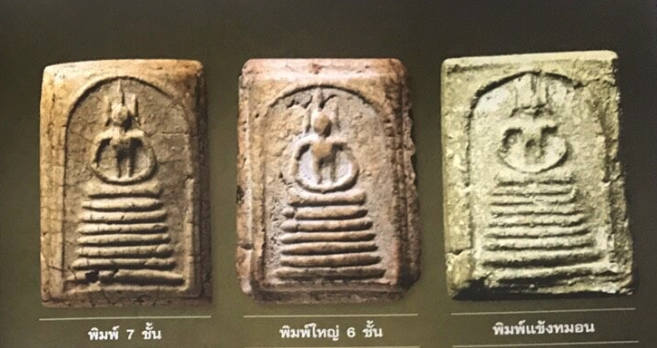
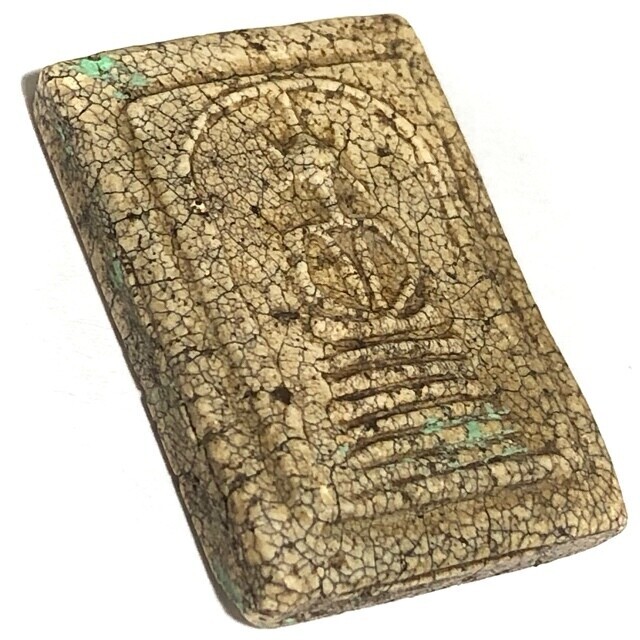
Below; a Study of Wat rakang Amulets of Somdej Pra Puttajarn (Dto) Prohmrangsri across 3 Eras; Amulet School by Ajarn Spencer
Spending time to look at a large number of Wat Gaes Chaiyo amulets will reveal how the authentic Somdej Dto amulet will be clearly discernible from later editions. Look at as many different examples of authentic and later made/fakes to train your eye into seeing the difference at a glance. If an amulet has a chip or a break that has happened later in the life of the amulet, then we have a chance to examine this factor. If there are no ways to see the condition of the inner cement, then we are stuck with looking at the 'Pim Song' and the surface, of the amulet. This requires us guessing what kind of environment and care the amulet has received, by looking at the markings and discolorations that may occur on the surface. The first and simplest factor to observe is perhaps the fact that the 'grorb' (outer frame) has overflowed the edges on all four sides, leaving them at irregular angles. The rear face will almost always show fingermarks, and when not it will show scratch lines from sand paper used on the rear surface.
Below; Kata Tutorial with Text for Pronuncation of Somdej Pra Puttajarn (Dto) Prohmrangsri's kata Chinabanchorn
Another important factor to know about in discriminating aged examples of Pra Somdej Wat Gaes Chaiyo is the fact that almost all of them are very dense and hard, but otherwise have the same silky soft feel to the touch when held in the hand as a Somdej Wat Rakang. Once this general characteristic has been understood, the 'Nuea Pra' (amulet material) of the Pra Somdej Wat Gaes Chaiyo can be subdivided into three varied textures/consistencies;
1. Nuea Num – a large amount of herbal mixture and Nam Man Dtang Iw, which
leaves a rather beigish white color with a slight orange-brown tone to it.
amulet has an oily, silky feel to the surprisingly compressed and hard outersurface. This kind of Nuea is called 'Nuea Jad'.
2. Nuea Num Bpaan Glang – has less amount of Muan Sarn and Nam Man Dtang Iw. It is whiter in color with a slight yellowish tint.
3. Nuea Graeng is much denser and harder than Nuea Num. It has a similar feel
to marble, and the Muan Sarn is less visible in the surface of the cement mixture.
The sacred powder mixture used for Wat Gaes Chaiyo amulets is in principle almost the same composition as the Pra Somdej Wat Rakang, with the slight difference that the Wat Gaes Chaiyo mixture is some what richer in Nam Man Dtang Iw (Tang Oil). This is what lends the oily look to the Wat Gaes amulets. The Pra Somdej Wat Gaes Chaiyo amulet from Luang Por Dto Prohmrangsri was made in 7, 6, 5 and 3 tiered dais version, but in the official collector circle, only the following Pim are classified and accepted in the Wat Gaes Chaiyo Pantheon, despite it being commonly known that, that there are other models in ecxistence, which are however rare, and few in numbers, and therefore hard to document.
• Pra Somdej Thaan 7 Chan (seven tiered Somdej
The Pra Somdej Wat Gaes Chaiyo amulets hold a significant place in Thai Buddhist amulet history. These amulets are accepted worldwide and in all societies, to have been made by Somdej Pra Puttajarn (Dto) Prohmrangsri of Wat Rakang Kositaram. The They are part of the The 'Sam Somdej Sam Wat' (Three Top Somdejs of Three Top temples) family of amulets, which also includes; Pra Somdej Wat Rakang Kositaram, Somdej Bang Khun Prohm and Somdej Wat Gaes Chaiyo. One important factor to note is that the Pra Somdej Wat Gaes Chaiyo amulets are directly connected to Somdej Dto who made these models to be released at Wat Gaes Chaiyo Worawiharn. They are highly esteemed and valued, and even rarer than the Pra Somdej Wat Rakang Kositaram, and equally rare as the Pra Somdej Wat Bang Khun Prohm.
These amulets are recognized as coming from one (or all) of four royal temples (counted as 3 due to 2 of the temples having blended into one): Wat Intr, Wat Gaet Chaiyo, Wat Hmai Bang Khun Prom, and Wat Rakang Kositaram. They undergo a Puttapisek blessing ceremony in the temple where they were made and are then taken to two or three other temples to be laid under the 'Pra Pratan' (main Buddha statue in the shrine) and absorb the prayers of the Sangha (Monks) for further sacredness and power.
The Pra Somdej Wat Gaes Chaiyo amulets are known for their distinct characteristics and textures. They have a dense and hard composition, but when held in the hand, they have a silky soft feel similar to Somdej Wat Rakang amulets. The Nuea Pra (amulet material) of these amulets can be divided into three varied textures: Nuea Jad, Nuea Num Bpa, and Nuea Graeng.
In terms of their appearance, the depth of relief of the Pra Somdej Wat Gaes Chaiyo amulets is very defined, making them easily recognizable and categorizable among the various classic Pra Somdej amulets. They often contain small particles of different-colored substances in the sacred powder, such as brown stains from Nam Man Dtang Iw and Gesorn pollen powders, and black stains from burnt powders, Bai Lan powder, or ground-up pieces of banana seeds .
It is essential to know, that here are variations within the Pra Somdej Wat Gaes Chaiyo amulets, such as the Pra Somdej Thaan 7 Chan (seven-tiered Somdej), Pra Somdej Thaan 6 Chan Ok Dtan, Pra Somdej Thaan 6 Chan Ok Rong, and Pra Somdej Thaan 6 Chan Ok Dtalord
The Pra Somdej Wat Gaes Chaiyo amulets are among the rarest amulets of all amulets, and hold great significance to Thai Buddhists, devotees of Somdej Pra Puttajarn (Dto) Prohmrangsri, serious collectors, and are highly sought after by believers for their sacredness, power to protect and bring success, wealth and status, and their connection to Thai Buddhist tradition. The Pim Hok Chan refers to the six-tiered model of the Pra Somdej Wat Gaes Chaiyo amulets. This particular model holds a special place among the various Pra Somdej amulets and is one of the rarest and most highly sought after models by collectors and believers.
